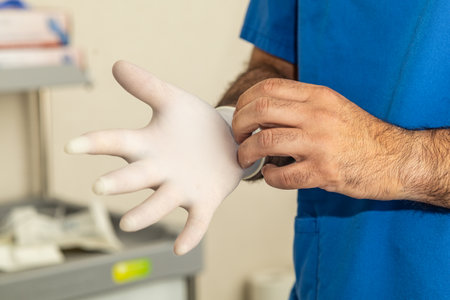Introduction to Post-Operative Care for Shoulder Surgeries
Effective post-operative management is a cornerstone of successful recovery following shoulder surgeries. In the context of the British population, it is essential to recognise that a one-size-fits-all approach may not yield optimal outcomes. The unique needs of patients in the UK, shaped by factors such as NHS protocols, community physiotherapy access, and cultural attitudes towards rehabilitation, require tailored strategies. Proper post-operative care not only minimises complications but also accelerates functional restoration, allowing individuals to return to their everyday activities and work commitments efficiently. Understanding these local nuances ensures that healthcare professionals deliver evidence-based interventions aligned with both clinical guidelines and patient expectations within British settings.
2. Pain Management Strategies in the UK Context
Pain management is a pivotal aspect of post-operative care following shoulder surgeries, and the approach within the UK is notably shaped by both National Health Service (NHS) guidelines and an emphasis on holistic, patient-centred care. Effective pain control not only enhances patient comfort but also facilitates early mobilisation and rehabilitation, which are crucial for optimal surgical outcomes.
Common Analgesic Protocols
In the British healthcare system, multimodal analgesia is commonly adopted to minimise opioid consumption while ensuring adequate pain relief. Typical protocols may include:
| Medication Type | Examples | Purpose/Notes |
|---|---|---|
| Non-Steroidal Anti-Inflammatory Drugs (NSAIDs) | Ibuprofen, Naproxen | First-line for mild to moderate pain; monitor for gastrointestinal or renal side effects. |
| Paracetamol | Regular dosing | Mainstay in most protocols; low risk of side effects. |
| Opioids (short-term) | Codeine, Tramadol | Reserved for breakthrough pain; used sparingly due to dependency concerns. |
| Regional Anaesthesia | Nerve blocks (e.g., interscalene block) | Often used intra-operatively; can provide significant post-operative relief. |
The Role of NHS Guidelines
NHS guidelines emphasise evidence-based practices, patient safety, and minimising harm. The NHS recommends stepwise escalation—starting with non-opioid medications and progressing only if necessary. Regular pain assessments using validated scales such as the Visual Analogue Scale (VAS) or Numeric Rating Scale (NRS) ensure tailored adjustments to analgesic regimens. Additionally, NHS policy encourages clear communication between healthcare teams and patients regarding expectations and safe medication use.
Integration of Medication and Non-Pharmacological Methods
The British approach often integrates non-pharmacological strategies alongside medication, reflecting a comprehensive view of pain management. Common techniques include:
- Cold therapy (ice packs) to reduce inflammation and discomfort immediately post-surgery.
- Patient education on activity modification and proper sling usage to prevent unnecessary strain.
- Cognitive-behavioural approaches such as guided relaxation or mindfulness for those experiencing persistent pain or anxiety.
Cultural Considerations in the UK
Bespoke care plans take into account patient preferences and cultural backgrounds, as well as local NHS resources. For instance, access to physiotherapy or occupational therapy may vary regionally, influencing the choice and timing of adjunctive therapies. Importantly, British practice places high value on shared decision-making, ensuring patients are partners in their own recovery journey.
Summary Table: Integrated Pain Management Approach in the UK
| Pain Management Component | Description in UK Practice |
|---|---|
| Pharmacological Interventions | Tiers of medication per NHS guidance; focus on minimising opioids. |
| Non-Pharmacological Methods | Cryotherapy, education, psychological support integrated routinely. |
| NHS Guidelines Influence | Evidence-based protocols ensure standardisation and patient safety. |
This integrated strategy reflects the UKs commitment to optimising post-operative outcomes through a balance of clinical efficacy, patient preference, and resource-sensitive practices tailored for the British population.

3. Physiotherapy and Rehabilitation Pathways
The post-operative management of shoulder surgeries within the UK places significant emphasis on evidence-based physiotherapy and structured rehabilitation pathways. These processes are integral to promoting optimal functional recovery, reducing complications, and ensuring patient satisfaction across diverse NHS Trusts and private practice settings.
Evidence-Based Physiotherapy Approaches
Current best practice in the UK revolves around individualised physiotherapy regimens tailored to the type of surgery performed—whether rotator cuff repair, shoulder stabilisation, or arthroplasty. The British Elbow & Shoulder Society (BESS) and Chartered Society of Physiotherapy (CSP) both advocate for early but controlled mobilisation, guided by pain levels and tissue healing timescales. Passive range of motion exercises typically commence in the initial weeks post-operatively, followed by gradual introduction of active movements and strengthening exercises as tolerated.
Referral Pathways in the UK
In Britain, referral to physiotherapy is generally initiated by orthopaedic consultants immediately following surgery or during follow-up outpatient appointments. The NHS employs standardised electronic referral systems that ensure timely access to community- or hospital-based musculoskeletal physiotherapists. For more complex cases or delayed recovery, multidisciplinary team meetings may be convened to coordinate care between surgeons, physiotherapists, occupational therapists, and pain specialists.
Standardised Rehabilitation Programmes
A hallmark of the UK’s approach is the utilisation of standardised rehabilitation protocols developed through national guidelines and local clinical governance frameworks. These programmes delineate clear milestones for progression through stages of recovery: protection phase, mobilisation phase, strengthening phase, and return to activity. Patient education is a central feature; individuals are provided with written materials and access to digital resources such as the NHS app or BESS online leaflets to support self-management at home. Regular assessment using validated outcome measures—such as the Oxford Shoulder Score—ensures objective monitoring of progress and informs any necessary modifications to therapy plans.
Overall, the British model underscores a collaborative, patient-centred approach grounded in current clinical evidence. By adhering to well-defined referral pathways and rehabilitation protocols, clinicians can facilitate safe return to function and maximise long-term outcomes following shoulder surgery.
4. Monitoring and Preventing Post-Operative Complications
Effective post-operative management of shoulder surgeries in the UK relies heavily on the early identification and prevention of complications, which may include infection, frozen shoulder (adhesive capsulitis), and venous thromboembolism (VTE). Adhering to national guidelines such as those set forth by NICE (National Institute for Health and Care Excellence) is fundamental for ensuring patient safety and optimal outcomes.
Early Identification: Clinical Vigilance and Patient Education
Healthcare professionals must remain vigilant during the initial weeks following surgery, as this period is critical for detecting complications. Patients should be educated about warning signs and encouraged to report symptoms promptly. This collaborative approach fosters timely intervention and minimises risk.
Common Complications: Signs and Preventive Measures
| Complication | Key Signs/Symptoms | Best Practice Prevention |
|---|---|---|
| Infection | Redness, swelling, increased pain, discharge, fever | Sterile dressing changes, hand hygiene, prompt wound review per NHS protocols |
| Frozen Shoulder | Pain with movement, progressive stiffness, restricted range of motion | Early mobilisation within prescribed limits, regular physiotherapy as per CSP guidelines |
| Thrombosis (VTE) | Leg swelling, tenderness, warmth, shortness of breath (if PE suspected) | Risk assessment using NICE guidance, timely mobilisation, prophylactic anticoagulants if indicated |
National Guidelines: Application in British Practice
The NICE guidelines recommend routine screening for infection at each follow-up appointment, especially in the first two weeks post-operatively. For VTE, a formal risk assessment should be conducted pre-operatively and repeated post-operatively; prophylactic measures are tailored to individual patient risk profiles. Frozen shoulder prevention hinges on early referral to physiotherapy services—timely access to NHS or private physio is crucial in the UK context.
Clinical Pathway for Monitoring Post-Operative Complications
| Post-Op Day/Week | Assessment Focus | Action if Concern Identified |
|---|---|---|
| Day 1–7 | Wound check, pain level, initial mobility assessment | Escalate to surgical team if infection or VTE suspected; urgent physio if stiffness develops |
| Week 2–6 | Suture removal (if non-absorbable), range of motion evaluation, ongoing VTE monitoring | Initiate imaging or blood tests as per NHS protocol; adjust rehabilitation plan accordingly |
| Week 6+ | Long-term functional recovery review, persistent pain/stiffness assessment | Referral to specialist if complications persist; consider MDT involvement for complex cases |
The integration of best practices derived from national guidelines ensures consistency in care across the British healthcare system. Regular communication between patients and multidisciplinary teams—including GPs, surgeons, nurses, and physiotherapists—underpins the successful prevention and management of post-operative complications after shoulder surgery.
5. Patient Education and Support
The Role of Patient Education in Recovery
Effective patient education is fundamental to optimal post-operative management of shoulder surgeries. In the British context, empowering patients with knowledge about their procedure, expected recovery timelines, and self-care techniques not only encourages adherence to rehabilitation protocols but also reduces anxiety and misconceptions. Thorough explanations about pain management, wound care, and warning signs of complications ensure patients are better equipped to participate actively in their recovery journey.
Resources Provided by the NHS and Charities
The National Health Service (NHS) offers a wealth of resources tailored for post-operative shoulder care. These include leaflets, online guides, and access to specialist physiotherapists who support patients through structured rehabilitation programmes. Additionally, British charities such as Versus Arthritis and ShoulderDoc provide educational materials, peer support forums, and helplines. Such organisations play a vital role in extending practical advice and emotional reassurance beyond the hospital setting, ensuring continuity of care across the country.
Culturally Sensitive Communication for a Diverse Population
The UK’s diverse population necessitates culturally sensitive communication in post-operative care. Healthcare professionals should be mindful of linguistic needs, religious considerations, and varying health beliefs when providing instructions or discussing treatment plans. Utilising interpreters or translated materials can bridge language gaps, while respecting cultural values fosters trust and engagement. By adopting an inclusive approach, clinicians ensure that all patients—regardless of background—receive equitable support throughout their shoulder surgery recovery process.
6. Return to Work and Daily Activities
Staged Return to Work: Balancing Recovery and Employment
The phased return to work following shoulder surgery is a critical aspect of post-operative management, particularly within the context of UK employment law and workplace culture. Under the Equality Act 2010, employers are required to make reasonable adjustments for employees returning after surgery. Practically, this means that a graded return – beginning with reduced hours or lighter duties – should be discussed between patients, their healthcare team, and employers. Sedentary or office-based roles may allow for an earlier return (often within 4–6 weeks), provided pain is controlled and functional range of motion is restored. However, those in manual or physically demanding jobs may need up to 12–16 weeks before resuming full duties. Communication with occupational health services can facilitate tailored adaptations in the workplace.
Resumption of Sport and Recreational Activities
Re-engagement with sports or recreational activities must be guided by both physiological healing timelines and individual progress through rehabilitation milestones. Non-contact, low-impact activities such as walking or gentle cycling can often be reintroduced within 4–8 weeks post-operatively. For more strenuous sports—particularly those involving overhead movements or contact (e.g., rugby, cricket)—return may be delayed until at least 4–6 months after surgery, subject to clinical assessment and physiotherapist approval. British sporting culture emphasises club participation; thus, clear guidance on progression and risk minimisation is important for safe reintegration into community teams or leagues.
Daily Living and Lifestyle Patterns in the UK
Adapting daily routines is essential for optimal recovery. Activities such as driving should only be resumed once independent control of the vehicle can be demonstrated—typically after 6–8 weeks—and patients must inform their insurer about any surgical procedures. Household tasks like shopping or gardening should follow similar staged principles: starting with light chores and progressing as strength improves. The British climate also necessitates caution regarding outdoor activities during colder months due to increased slip risks. Support from family, friends, and local community resources can play a significant role in facilitating independence during recovery.
Guidelines for Safe Reintegration
- Open dialogue: Maintain communication with employers regarding necessary adjustments and phased responsibilities.
- Seek professional advice: Consult your surgeon or physiotherapist before resuming complex or physically demanding tasks.
- Respect legal obligations: Adhere to statutory sick pay regulations and workplace health & safety guidelines during your return.
Summary
A successful return to work, sport, and daily life after shoulder surgery requires structured planning, compliance with UK-specific regulations, and recognition of cultural lifestyle patterns. Gradual progression—supported by medical guidance—ensures both safety and sustained recovery outcomes for the British population.


